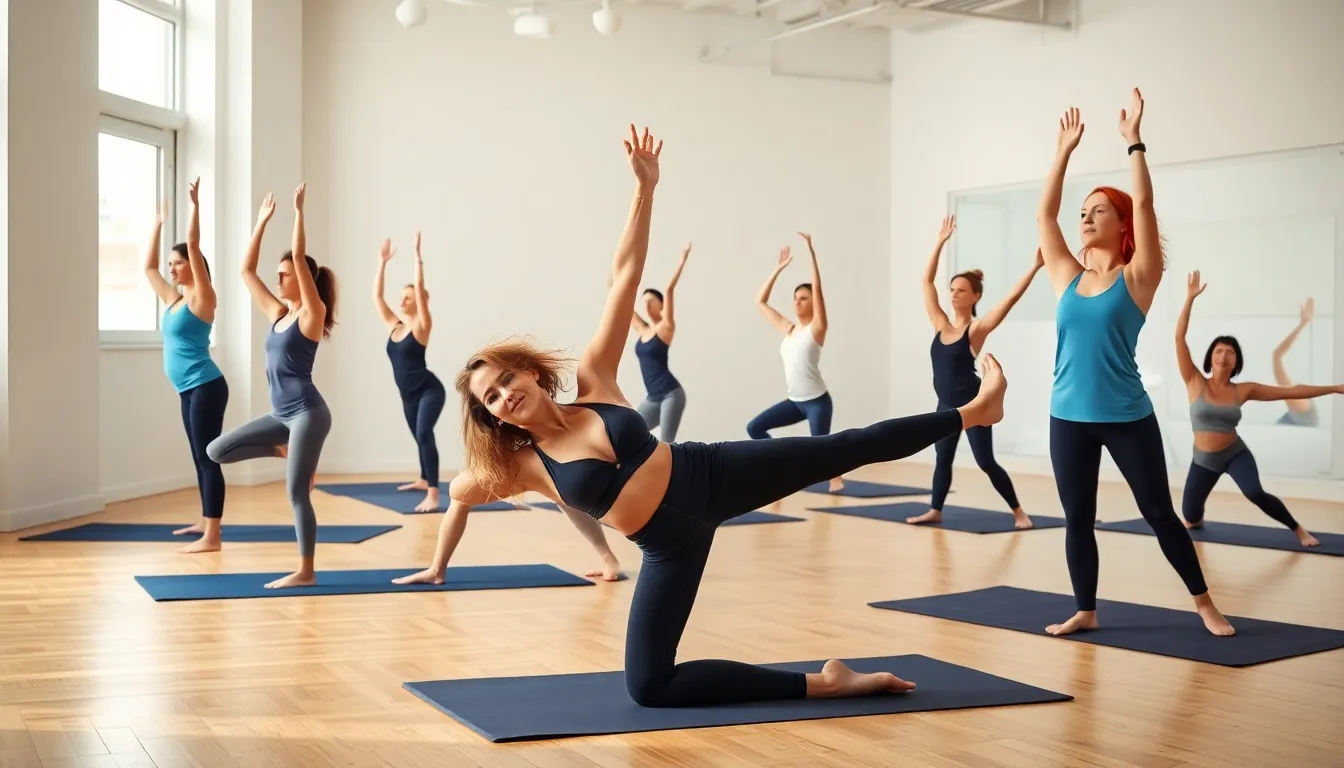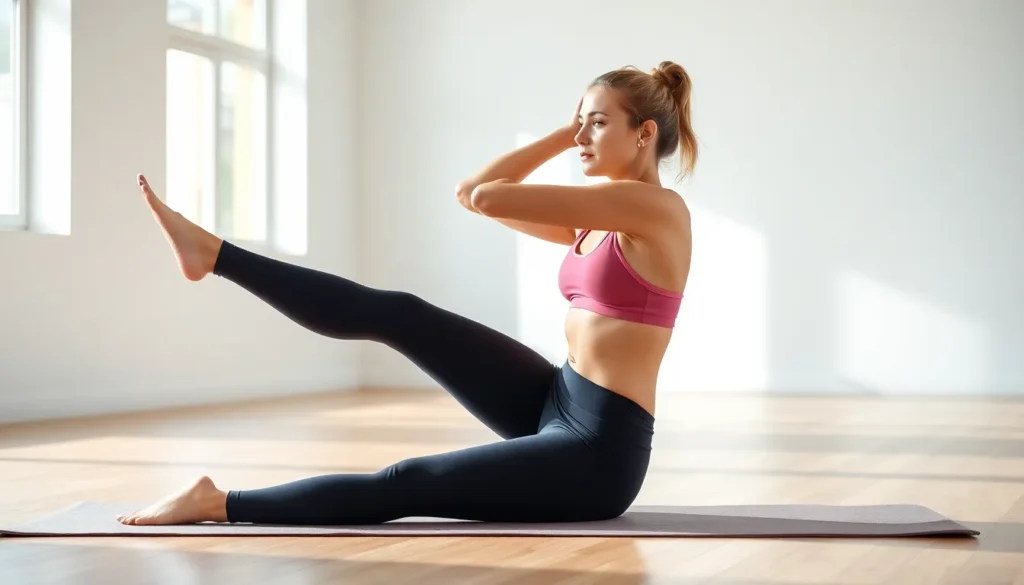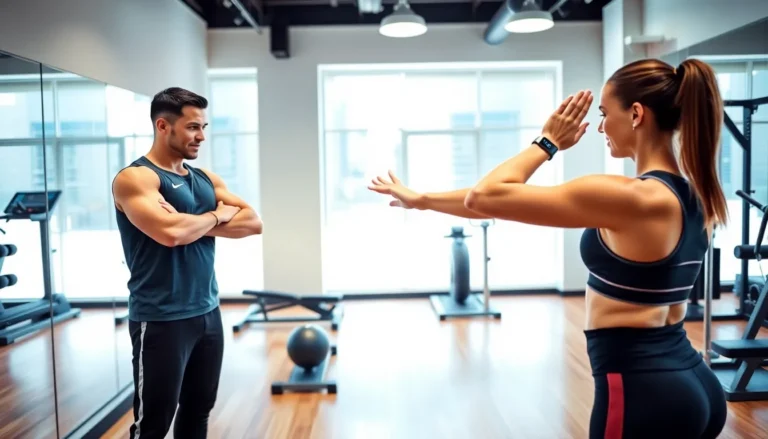Table of Contents
TogglePilates has taken the fitness world by storm, offering a unique blend of strength, flexibility, and mindfulness. For beginners, this low-impact exercise method provides an accessible entry point to improve overall well-being. With its focus on core strength and alignment, Pilates helps individuals build a solid foundation for physical fitness.
As they embark on this journey, newcomers will discover how Pilates enhances posture, reduces stress, and promotes body awareness. Whether in a studio or at home, the principles of Pilates can be easily adapted to suit all fitness levels. With the right guidance and a commitment to practice, anyone can unlock the transformative benefits of Pilates and enjoy a healthier lifestyle.
What Is Pilates?
Pilates is a low-impact exercise method designed to improve strength, flexibility, and posture. Developed in the early 20th century by Joseph Pilates, it focuses on core stability and alignment, promoting overall body awareness and mindfulness. The practice incorporates controlled movements and breathing techniques, creating a strong foundation for physical fitness.
Pilates exercises can be performed on a mat or using specialized equipment, such as a reformer, which provides resistance to enhance strength training. Participants learn to connect with their bodies, which can lead to improved coordination and balance. As a holistic approach to fitness, Pilates emphasizes the relationship between mind and body, encouraging practitioners to focus on precision and form.
Beginners often appreciate Pilates for its adaptability. Modifications exist to accommodate various fitness levels, making it suitable for individuals from different backgrounds. As such, newcomers can safely engage in Pilates and start reaping its benefits, including increased muscle tone, enhanced flexibility, and reduced risk of injury.
Benefits of Pilates for Beginners

Pilates offers numerous advantages for individuals new to fitness. These benefits span physical and mental aspects, making it a well-rounded practice for beginners.
Physical Benefits
- Improved Core Strength: Pilates emphasizes core engagement, enhancing strength in abdominal muscles and back support. This leads to better posture and reduced back pain.
- Increased Flexibility: Regular Pilates practice stretches muscles and improves range of motion in joints, resulting in enhanced overall flexibility.
- Enhanced Muscle Tone: Resistance training through body weight and equipment leads to visible toning of muscles. Participants often notice improved definition in key areas.
- Better Posture: Pilates encourages awareness of body alignment, which promotes proper posture. Improved posture can alleviate discomfort and enhance confidence.
- Reduced Risk of Injury: Low-impact movements minimize strain on the body, making it safer for beginners. Strengthening stabilizing muscles leads to greater injury prevention.
- Enhanced Balance and Coordination: Pilates movements focus on control and precision, increasing overall balance and coordination. This translates to improved performance in other physical activities.
Mental Benefits
- Stress Reduction: The mindfulness component of Pilates encourages relaxation and stress relief. Participants often find a calm, centered state during practice.
- Increased Body Awareness: Pilates promotes awareness of muscle engagement and body alignment. This heightened awareness extends beyond the session, benefiting daily movements.
- Improved Focus: Concentration required during Pilates exercises enhances mental clarity. This practice sharpens focus and attention, which can affect overall productivity.
- Heightened Mind-Body Connection: Pilates fosters a deeper understanding of the relationship between body and mind. This connection enhances overall well-being and promotes healthier lifestyle choices.
- Boost in Confidence: As individuals gain strength, flexibility, and control, their confidence typically improves. Achieving fitness goals within Pilates practice can foster greater self-esteem.
Getting Started with Pilates
Starting Pilates involves understanding essential equipment and mastering basic exercises that form the foundation of the practice.
Essential Equipment
Pilates can be practiced with minimal equipment, making it accessible. At a minimum, individuals need a mat, which provides cushioning and stability during exercises. Pilates rings enhance strength and resistance, while resistance bands add versatility to workouts. For those seeking to use specialized equipment, reformers offer adjustable resistance to facilitate a wide range of exercises. Beginners should focus on essential items that aid in alignment and support.
| Equipment Type | Purpose |
|---|---|
| Mat | Provides cushioning and stability |
| Pilates Ring | Enhances strength and resistance |
| Resistance Bands | Adds versatility to workouts |
| Reformer | Facilitates diverse exercises |
Basic Pilates Exercises
Starting with fundamental moves builds confidence and competence. Here are key exercises for beginners:
- The Hundred: This breathing exercise promotes core activation and increased blood circulation.
- Roll-Up: This exercise improves spinal articulation and strengthens the abdominal muscles.
- Single-Leg Stretch: This move engages the core and enhances flexibility in the hip joints.
- Plank: This foundational exercise boosts overall core stability and strength.
- Bridge: This exercise targets the glutes and hamstrings while promoting spinal alignment.
Engaging in these basic exercises provides a solid introduction to Pilates, ensuring a well-rounded experience and preparation for more advanced techniques.
Common Mistakes to Avoid
Beginners often make several common mistakes in their Pilates practice that can hinder their progress and lead to injuries. Awareness of these pitfalls ensures a safer and more effective workout experience.
- Neglecting Core Engagement
Beginners sometimes fail to engage the core muscles properly. Core activation provides stability and supports movement. Developing this fundamental connection enhances overall performance and reduces the risk of strain.
- Rushing Through Exercises
Many newcomers rush through movements, compromising form and effectiveness. Slow, controlled motions promote better muscle engagement and alignment. Concentrating on precision yields greater benefits and reduces injury risk.
- Ignoring Breathing Techniques
Breathing plays a critical role in Pilates. Individuals often forget to synchronize their breath with movements. Implementing breath control enhances concentration, promotes relaxation, and provides necessary oxygen to muscles.
- Overextending or Straining
Beginners might push their limits too soon, leading to overstretching or straining. It’s important to listen to the body and avoid movements that feel uncomfortable. Progressing gradually protects against injury and fosters a sustainable practice.
- Forgetting Proper Alignment
Maintaining proper alignment is crucial for effective Pilates practice. Many beginners overlook the significance of body alignment during exercises. Focusing on alignment ensures that movements target the intended muscle groups and minimizes strain.
- Neglecting Modification Options
New practitioners often disregard modifications suited to their fitness levels. Taking advantage of modifications for specific exercises accommodates various abilities. This approach allows individuals to build strength and confidence safely.
- Skipping Professional Instruction
Many beginners practice without proper guidance, increasing the risk of developing bad habits. Engaging with a certified instructor provides valuable feedback and corrections. Professional instruction accelerates learning and enhances overall technique.
- Setting Unrealistic Expectations
Beginners sometimes set unrealistic expectations for immediate results. Building strength and flexibility takes time and consistent effort. Embracing the process fosters patience and encourages long-term commitment.
Tips for Success in Pilates
- Focus on Core Engagement: Engaging the core stabilizes the body and supports movement. Ensure core muscles are activated throughout each exercise to maximize results.
- Maintain Proper Alignment: Visualize a straight line through the head, shoulders, and hips. Correct alignment prevents strain and enhances effectiveness in exercises.
- Practice Controlled Movements: Emphasize slow and deliberate movements over speed. Controlled execution refines technique and reduces injury risk.
- Integrate Breath with Movement: Coordinate breathing with exercise. Inhale during preparation and exhale during exertion to enhance performance and body awareness.
- Use Quality Equipment: Invest in a high-quality Pilates mat for stability and cushioning. Consider additional equipment, such as resistance bands or rings, to diversify workouts.
- Begin with Fundamental Exercises: Start with basic moves like The Hundred, Roll-Up, and Bridge. Mastering these foundational exercises builds confidence and prepares for more complex routines.
- Set Realistic Goals: Establish achievable short-term and long-term fitness goals. Focus on gradual progress rather than immediate results to stay motivated.
- Seek Professional Guidance: Take classes from certified instructors, especially for beginners. Professional instruction ensures proper technique and personalized feedback, accelerating learning.
- Stay Consistent: Commit to a regular practice schedule. Aim for at least two to three sessions per week to observe significant improvements in strength and flexibility.
- Listen to Your Body: Tune into the body’s signals. Modify or skip exercises that cause discomfort, and don’t hesitate to consult a professional for advice on any pain experienced.
- Stay Hydrated: Drink water before, during, and after sessions. Hydration supports physical performance and recovery during Pilates practice.
- Be Patient and Persistent: Embrace the learning process. Progress takes time, so patience is essential in achieving fitness goals through Pilates.
Pilates offers beginners a unique pathway to improved fitness and well-being. By focusing on core strength and mindful movement, it creates a solid foundation for anyone looking to enhance their physical and mental health. With its adaptability and low-impact nature, Pilates caters to various fitness levels, making it an ideal choice for newcomers.
As individuals embark on their Pilates journey, embracing patience and consistency will lead to lasting benefits. By staying mindful of proper techniques and setting achievable goals, they can enjoy a fulfilling practice that fosters growth and confidence. Ultimately, Pilates not only transforms the body but also nurtures the mind, paving the way for a healthier lifestyle.




